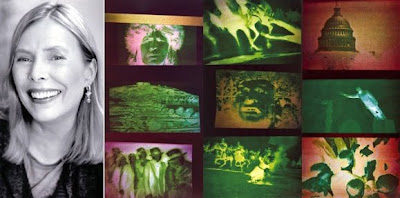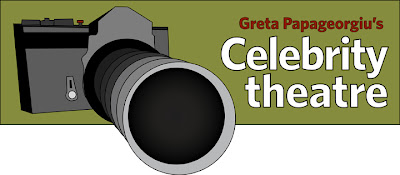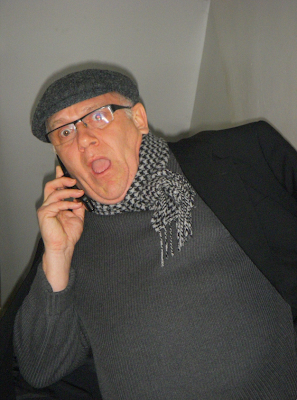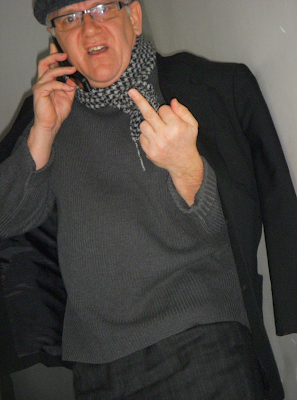Date: 2008 June
 My First Headshot (1999).
My First Headshot (1999).By Michael Wheeler
A strange thing happened to me this year: I ended up splitting with my fancypants agent and doing more acting than I’d done in the four previous years with representation. It wasn’t something I’d planned. It just kinda developed, and it has me thinking all sorts of things about how and what I want to do in the theatre.
A year and a half ago I had seriously considered hanging up my acting shoes. Being Co-Artistic Director of an indie company and directing shows around town was fulfilling and taking up a huge amount of time. Running around to audition to be an SOC hockey fan in an insurance commercial, or talking broccoli (aka a principal role) in a Sobey’s spot seemed to be a distraction for the most part. I had been given some friendly advice from several quarters that “you can’t be all things to all people” and that if I really wanted to make a name for myself as a director, I should firmly establish myself exclusively as one.
This also made sense to me because acting wasn’t too much fun anymore. When I finished my acting MFA in The States I did the mandatory 1 year in NYC that your visa allows for. I turned into a serious stress case of an actor with essentially 10 months to become wildly successful in order to extend my stay. I started with a part in a show at The Ontological Theatre and spun that into a mediocre agent who also doubled as a radio commentator for the New York Giants. I hustled like crazy between open calls, what the agent could find me, and up to 5 different joe jobs, but much to my dismay I did not find myself wildly successful.
This was partially because the odds of this working out for me were pretty low, but also because of how I was performing and auditioning. The whole I must define my career with this performance attitude the situation had me left me too tense and probably in hindsight, desperate, to really do anything like that. I returned to Toronto just in time for SARS, signing on as the first male client of a failure of a startup agency before landing an agent who was decidedly blue-chip a year later.
The pitiful state of the industry and being the smallest name on a big time roster meant opportunities to audition for projects that weren’t advertising came on a bi-monthly basis. Six, five-minute opportunities a year, to establish myself. It wasn’t cool. I kept myself in classes, volunteered to read for casting directors, but nothing seemed to give. The experience contrasted heavily with the success we were having with Praxis and the whole being an actor for hire thing started to feel like a raw deal. Eventually the agent and I mutually agreed that we “were not a good match”.
 Fort at York workshop #1.
Fort at York workshop #1.So I kind of surprised myself when I showed up to audition for The Fort At York. Over the course of two publicly presented workshops, I played first a mute kitchen boy named with a tendency to break into monologue, and eventually a soldier named Everett with some serious psychological problems in the final production. This led directly to playing an anarchist artist in Save Us at HATCH this year, I followed it immediately by acting in a Praxis Theatre show for the first time as The Prosecutor in our workshop presentation of Stranger.
And all of a sudden acting was a) fun again and b) I was much better at it. The major reason for this was simple: I no longer felt this overwhelming compulsion to make my career with a single performance. My breathing was controlled, shoulders went back, I found stillness, and had confidence in my ability to entertain without striving to entertain. All the little things I understood from my training intellectually, but hadn’t been able to incorporate practically with regularity. It’s tough to breathe from support and have crisp final consonants when you’re trying desperately to succeed like no one has ever succeeded before.
 Save Us reading at Cameron House.
Save Us reading at Cameron House.I am grateful to Tara Beagan, Chris Reynolds, Chad Dembski and Simon Rice for creating three shows that really fostered an exchange of ideas and valued collaboration in rehearsal. I had a lot of confidence in these projects because I was afforded the opportunity to play a part in things from the get-go. I also remembered something I forgot: I love opening night. As a kid I had hoped first to play for The Toronto Blue Jays and later, as a starter on any NBA team but The Utah Jazz. It was only after both of these goals proved entirely unrealistic that I started to get heavily into theatre at 16. In hindsight, I think I know why now:
Opening night as a performer, and all the shows that follow, is the closest you can get to approximating Game Day in sports. There is a specific time where you have to show up in front of a crowd of people. You get one chance to do something special with your teammates. The nerves, the excitement, the onus on yourself to thrive under pressure – once I lost an impossible sense of tension and just concentrated on the task at hand – it became addictive again. If I’m not going to play in the NBA Finals, this is as good as it’s going to get. And it’s pretty good.
So Mike the actor is back – resurrected from the graveyard of classic frustrations that plague actors in their first years out of a training program. Screw pigeonholing myself. Theatre pays so poorly we ought to do exactly the types of projects we would like to do and often you have to find these things yourself. And maybe a new agent.
This is the third in a series of four blog posts on theatre by Praxis Theatre Co-Artistic Director Michael Wheeler.
 Sounds impossible – and slightly suspect – we know. But here’s what we’re thinking: Send us a digital version of your 2008 Toronto Fringe Festival postcard or poster, and we’ll post it here on our blog, sometime between now and the end of the festival. Simple.
Sounds impossible – and slightly suspect – we know. But here’s what we’re thinking: Send us a digital version of your 2008 Toronto Fringe Festival postcard or poster, and we’ll post it here on our blog, sometime between now and the end of the festival. Simple.
We get to learn more about your show, look at your awesome postcard, and everyone wins.
Please send your Toronto Fringe Festival postcards here.
By the way, does anybody have any fun stories about an upcoming North American Fringe Festival? What are you working on?
 By Michael Wheeler
By Michael Wheeler
In an attempt to prove I am bi-hyperbolic (my hyperbole goes both ways), I return from my anti-Luminato crusade on a positive note. If you are against some things you should be for other things.
Man do I love Dufferin Grove Park in the west end of Toronto. It’s The Greatest. It reaches its zenith with the Cooking Fire Theatre Festival, which opens tomorrow and runs through Sunday. I really do think there is a convincing argument to make it the pinnacle of Western progress in terms of exemplifying the values, principals, and aspirations we have arrived at thus far. (With a particular bias towards my own values, principals and aspirations.)
It was not always thus. There was a while back in the 90s where it was not much a public space. Just a kind of mundane shortcut on your way to the many dollar stores housed inside the Dufferin Mall. Not dangerous, but maybe dodgy. In any case, it was underused and a little forlorn. But miraculously, for once, the forces of gentrification have abandoned the dark side and pulled off something truly miraculous.
The place has transcended into some sort of actual, non-theoretical, social democratic utopia. Sometimes the biggest miracles are the ones staring you right in the face. There have been the usual basics added that make a public space somewhere you want to be: Safe, clean, well maintained, a sports field, a leafy area with benches, fire pits, a massive kids’ area with multiple playgrounds and a wading pool. It’s all first rate.
It’s the extra things that the staff of the park have worked very hard to integrate that really sets it apart though:
Food: Sunday, Tuesday, and Wednesday afternoons you can make your own pizza in the park ovens for just $2.50 – Principal toppings: The vegetables that grow right there in the park garden. Friday nights, chefs prepare incredible dishes exclusively from the ingredients bought at the organic market. Soup is $2; a full meal is $6!
Organic market: The weekly Thursday organic farmers’ market has become an institution in Western downtown Toronto. It’s HUGE. If it’s organic, or grain-fed, or generally best solution for sustainable existence on this planet, they’ve got it. Some items are still pricey, but that has to do more with economy of scale and will work itself out over time.
Community programming: Just right now, in June, there are community drop-in games of cricket, soccer, ultimate frisbee, youth ball hockey, and a gardening clinic! The park also plays home to a myriad of community-based festivals throughout the temperate months. Also if you and your friends, team, family, etc. want to have a bonfire in one of the two fire pits, they’ll give you some training and hook you up no problem.
 Most impressive to me though as a theatre guy is the Cooking Fire Theatre Festival. Now in its fifth year, the festival pulls off for one week what no other theatre festival does: A presentation of really great plays by the people for the people. What do I mean by this?
Most impressive to me though as a theatre guy is the Cooking Fire Theatre Festival. Now in its fifth year, the festival pulls off for one week what no other theatre festival does: A presentation of really great plays by the people for the people. What do I mean by this?
Although there is an international element to how Artistic Director Kate Cayley curates the festival, the majority of the works are created and presented by local artists. These are plays that attempt to be accessible to everyone who frequents the park without sacrificing artistic integrity. Kids, hippies, theatre buffs, parents, random folks who just happened to be walking through the park: all the regular folks we have such a hard time pulling to the theatre. Most Artistic Directors would salivate at the diverse audience base the festival has attracted with this focus. There is none of the elitist, moneyed; culture is for those 60+ with $50+ for a ticket notion that’s killing us right now.
True to its name, each evening begins with a park-created dinner similar to the weekly Friday night meal. Productions take place throughout the park and the audience is led through the various performance sites by volunteers. Halfway through, naturally, there is a park-catered coffee and desert break. The final show almost always starts as darkness falls. The younger kids get packed off to bed, the generators get fired up, and what started with a sunny outdoor folk festival kind of feel, finishes as something full of shadows and mystery. Then, if you’re really good, you go help the kitchen folk who are struggling with a mountain of dishes, ’cause this is not a disposable cutlery kind of place. And you leave feeling great about yourself, your community and the place you live.
Saturday June 21st and Sunday June 22nd, the Festival starts early at 5pm in order to present a Theatrurtle pre-dinner production of Alphonse, by Wajdi Mouawad, performed by Alon Nashman. These are legitimately two of Canada’s top talents in the theatre world. All things being the same, it is probably not a bad idea to hit the festival on the weekend and catch this one too
Because this is a virtual utopia and not an actual one, there are small problems in Dufferin Grove. The guys that hang around the basketball courts and the moms pushing SUV-sized strollers to the organic market have their beefs with one another, and there has been a ridiculous debate amongst residents about installing an environmentally friendly toilet. This is small (likely organic) potatoes compared with what a united community and some dedicated staff have accomplished here though.
Everyone is welcome in this public space and these many disparate groups have found a way to co-exist and really thrive. Because of its location in a downtown neighborhood in the world’s most multicultural city – people from almost every class, income level, and ethnicity uses this public space on a given day. It feels like home to everyone. Where else in the world can you say that about? I’m calling it the pinnacle of Western Civilization until someone proves me otherwise.
This is the second in a series of four blog posts on theatre by Praxis Theatre Co-Artistic Director Michael Wheeler.
 Sounds impossible – and slightly suspect – we know. But here’s what we’re thinking: Send us a digital version of your 2008 Toronto Fringe Festival postcard or poster, and we’ll post it here on our blog, sometime between now and the end of the festival. Simple.
Sounds impossible – and slightly suspect – we know. But here’s what we’re thinking: Send us a digital version of your 2008 Toronto Fringe Festival postcard or poster, and we’ll post it here on our blog, sometime between now and the end of the festival. Simple.
We get to learn more about your show, look at your awesome postcard, and everyone wins.
Please send your Toronto Fringe Festival postcards here.
By the way, does anybody have any fun stories about an upcoming North American Fringe Festival? What are you working on?
We’re a couple of days behind on posting this, but the 2008 Dora Award nominations for Independent Theatre are in.
Here’s the full list of nominees in the independent theatre category:
Outstanding new play
Anusree Roy – Pyaasa
Michael Rubenfeld – My Fellow Creatures
Beatriz Pizano – Madre
Michael Hollingsworth – Laurier
Brendan Gall – A Quiet Place
Outstanding production Waiting for Godot – Modern Times Stage Company
Lullaby – Dark Horse Theatre
Laurier – VideoCabaret
April 14, 1912 – Theatre Rusticle
A Quiet Place – single threat
Outstanding direction
Soheil Parsa – Waiting for Godot
Nina Lee Aquino – People Power
Michael Hollingsworth – Laurier
Allyson McMackon – April 14, 1912
Geoffrey Pounsett – A Quiet Place
Outstanding performance by a male
Nicco Lorenzo Garcia – People Power
Benjamin Clost – My Fellow Creatures
David Ferry – Lullaby
Ryan Hollyman – Lawrence and Holloman
Christopher Stanton – A Quiet Place
Outstanding performance by a female
Erin Shields – The Unfortunate Misadventures of Masha Galinski
Anusree Roy – Pyaasa
Marcia Bennett – Madre
Maev Beaty – Dance of the Red Skirts
Pragna Desai – Canada Steel
Karin Randoja – Breakfast
Outstanding set design
Trevor Schwellnus – Waiting for Godot
Camellia Koo – People Power
Trevor Schwellnus – Madre
Lindsay Anne Black – April 14, 1912
Jackie Chau – Antigone: Insurgency (Sophocles Revisited)
Outstanding costume design
Angela Thomas – Waiting for Godot
Jenna McCutchin – The Fort at York
Astrid Janson and Sarah Armstrong – Laurier
Nina Okens – Bella Donna
Lindsay Anne Black – April 14, 1912
Outstanding lighting design
Andrea Lundy – Waiting for Godot
Michael Spence – Raging Dreams – into the visceral
Trevor Schwellnus – Madre
Andy Moro – Laurier
Laird Macdonald – Breakfast
Michelle Ramsay – April 14, 1912
Outstanding sound design/composition
Romeo Candido – People Power
Thomas Ryder Payne – Madre
Brent Snyder – Laurier
Richard Windeyer – Breakfast
Christopher Stanton – A Quiet Place
Wow! What a wonderful year it has been in Toronto’s independent theatre. Congratulations to all nominees and best of luck at the Monday, June 30 Dora Awards ceremony.
 Please join Praxis Theatre tonight for the season finale in our series of original play readings. This month, we are pleased to present Catherine Hernandez’s Kilt Pins.
Please join Praxis Theatre tonight for the season finale in our series of original play readings. This month, we are pleased to present Catherine Hernandez’s Kilt Pins.
WHAT: Reading of Catherine Hernandez’s Kilt Pins
WHEN: Tuesday, June 10 @ 8 pm
WHERE: The Lower Ossington Theatre
100A Ossington Avenue (one block north of Queen St.)
CAST: Pip Dwyer, Jo Chim, Simon Rice, Greta Papageorgiu, Tania McCartney, Margaret Evans, James Murray. Directed by Michael Wheeler.
TICKETS: Pay-What-You-Can @ the door
For more information, please contact Laura Nordin.
 By Michael Wheeler
By Michael Wheeler
This post is not about the art being presented at Luminato. There are a lot of really cool works being presented at the festival and I wish all the artists involved enormous success. Except for Joni Mitchell. What? Joni Mitchell is a visual artist!?!
This post is about money. Cash dollars for the arts. How it is spent, who decides, and for what purpose. I didn’t really understand how off the rails this whole spectacle had gone until I read Kate Taylor’s May 24th , 2008 article From zero to $22.5-million in 2 years in The Globe and Mail.
And then my head exploded.
Taylor begins by answering some of her own questions:
“How did a 10-day Toronto arts festival, which had completed only one season, win a direct provincial grant of a kind usually reserved for established government agencies? How did Luminato, that ill-defined grab bag of splashy public spectacles and pricey international performances (which gets underway for a second season on June 9) come out of nowhere so fast?
The answer is: one part strategy, one part timing, many parts political connections.”
She comes to the conclusion based on the following evidence:
The festival was founded and is co-chaired by Tony Gagliano and David Pecault. Gagliano is CEO of St. Joseph Communications, which publishes Toronto Life, and is also friends with Greg Sorbara, former Liberal finance minister and architect of McGuinty election victories. To complicate matters, his family also donated $10 million to the recent AGO renovation. This is relevant because the three major grants for the arts by the Ontario Government recently have been to the AGO, the ROM and Luminato. There is a strange, out of my just-trying-to-make-rent league, cycle of money going on there.
Pecault is Senior Partner with The Boston Consulting Group but, surprise, is married to Helen Burstyn, a prominent Liberal supporter who used to work inside McGuinty’s office and is now volunteer chair of The Ontario Trillium Foundation, another provincial arts granting body.
These well-connected founders managed to immediately, out of nowhere, get our Ontario government to commit $7.5 million dollars towards this festival over its first three years. What the? Praxis Theatre has to receive three successful project grants before we can even qualify to apply for operational funding. But fine, the post-SARS tourist economy ain’t what is used to be and some stimulus that skips the red tape is perhaps in order. But this latest, no-application process, trust us we’ll do something good with it, extra $15 million dollars – which Luminato admits that they don’t know what to do with yet – is quite frankly beyond the pale.
Here’s the top three reasons why:
First, access to public arts funding should not be political. Public money can’t and shouldn’t be about who you know. We have a hard time making the case for public arts funding period. Why not house the homeless, make the TTC cheaper, and paint some more bike lanes instead? If it begins to be even perceived as a slush fund for political friends to throw exclusive red carpet parties, while they wine and dine international artists, we’re screwed selling this idea to the rest of our citizens. The connection between the co-chairs and the Premier’s office are embarrassingly obvious. For all of us in the arts.
Second, there has been much to do in the media, and on this blog, about what’s wrong with theatre in Toronto as of late. In particular the lack of strong new voices and the conditions many artists work in. Alec Scott’s Toronto Life Article (who publishes Toronto Life again?), comes to mind. A lot of arguments have debated whether or not the criticisms are valid – not much talk about why they could be true. I think the answer is money and access to it. The more people that live here, make plays, and can find a way to live, the more exciting new art will be made. Throwing $15 million at Luminato will do little to address this for Toronto theatre.* If you think you know about the other disciplines being presented at the festival, let me know. It’s going to do very little to address the root causes of what plagues us in Theatretown.
*Note. Yes. The Luminato windfall was immediately followed by a $5 million increase to the Ontario Arts Council yearly budget to deflect this sort of criticism. But consider these #s: With the new money, The OAC distributes $60 million a year to roughly 400 organizations. This is peanuts, we’re talking $150,000 a piece after a rigorous process of peer review. Right now Luminato is rocking along with an average of $7.5 million a year and they just invented themselves.
Third, and most importantly, this is bad strategy. It’s the same kind of Lastman-era flawed logic that got us a basketball team named The Raptors and the notion that somehow we can buy a world class city instead of building one. Hiring a high-priced American Artistic Director to bring World Class shows to Toronto will not put us on the map as an international hotbed of talent. People travel to London and New York for this reason because of the shows that are created there, and the tradition the community has of making great works that push boundaries. That’s when the rest of the world follows suit and tries to participate with it as well. Until we have more legitimate domestic talent, stars, and the hits that go with them, we’re never going to achieve that sort of status.
So I’m Lumi-not-going. There are a bunch of shows, both domestic, and international, that seem really interesting. Normally I probably would check them out. But I’m disturbed enough by all of this to opt out. I’ve got a grant application I should probably be working on anyhow.
This is the first in a series of four blog posts on theatre by Michael Wheeler.

 Toronto-based actor Terrence Bryant – fresh from wrapping My Fellow Creatures at Theatre Passe Muraille – gets ambushed by Praxis paparazzi.
Toronto-based actor Terrence Bryant – fresh from wrapping My Fellow Creatures at Theatre Passe Muraille – gets ambushed by Praxis paparazzi.
 He wasn’t happy to see the press.
He wasn’t happy to see the press.
Last week, we asked for help to create a definitive list of Toronto theatre blogs. Here’s what we’ve got so far:
BlogTO – Theatre
Case Study: The House at Twenty-Seven Edgedale Road
Chris Dupis
Notes from the 3Cs
Off the Fence
Spinning/and/spinning
Theatre is territory
This is a great start, but we can’t help feeling like we’re missing some. Anyone know of any other Toronto-based theatre blogs? They could be actor blogs, production blogs, company blogs, or any other kind of blog, as long as they primarily relate back to theatre.
And while we’re at it, why don’t we broaden our search to include Canadian theatre blogs: We’re now looking for all Canadian theatre blogs.
As always, please pass along any relevant links by dropping a link in the comments section below, or by sending us an email. We’ll post the revised list next week. Thank you!













Recent Comments